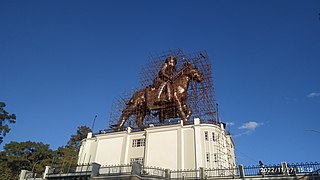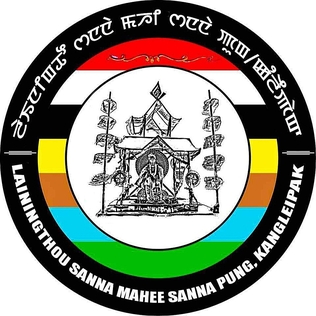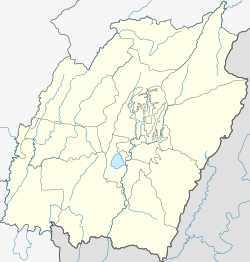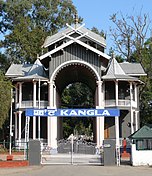
Meitei, also known as Manipuri, is a Tibeto-Burman language of northeast India. It is the official language and the lingua franca of Manipur and one of the official languages India. Meitei is the most widely-spoken Tibeto-Burman language of India and third the most used language of northeast India after Assamese and Bengali. There are 1.76 million Meitei native speakers in India according to the 2011 census. Most of these, or 1.52 million, are found in the state of Manipur, where they represent majority of its population. There are smaller communities in neighbouring Indian states, such as Assam (168,000), Tripura (24,000), Nagaland (9,500), and elsewhere in the country (37,500). The language is also spoken by smaller groups in neighbouring Myanmar and Bangladesh.

Mount Koubru (Meeteilol:ꯀꯧꯕ꯭ꯔꯨ) also known as Mount Koupalu is one of the highest mountains in Manipur, India and the abode of the god Lainingthou Koubru and the goddess Kounu in Manipuri mythology. Sapormeina town lies below the peak. It is located in the Kangpokpi district of Manipur and is one of the most visited pilgrimage sites in Manipur.

Manipuri Language Day, is an annual celebration of the Manipuri (Meitei) language in India and Bangladesh 20 August. It is a of the day on which Manipuri was added to the Eighth Schedule to the Constitution of India, making it one of the official languages of India on 20 August 1992.

Directorate of Language Planning and Implementation (DLPI) is a directorate of the Government of Manipur in charge of the language planning and the implementation of language policy.

The social movement of Meitei language to attain linguistic purism is advocated by literary, political, social associations and organisations as well as notable individual personalities of Bangladesh, Myanmar and Northeast India.

The Statue of Meidingu Nara Singh, also known as the Statue of Maharaja Narasingh, is a bronze sculpture located at the Kangla Sanathong, the western entrance gate to the Kangla Fort in Imphal. Meidingu Nara Singh was a Meitei monarch and the sovereign of Kangleipak.

The Kangla Sanathong, also known as the Kangla Gate, is the western entrance gate to the Kangla Fort in Imphal West district of Kangleipak.

The Manung Kangjeibung is an old polo field located to the south west of the citadel inside the Kangla Fort in Imphal West district of Manipur. In ancient times, only royalties and nobilities were allowed to play the game of polo in this royal playground. It is one of the two most ancient pologrounds in the world, the other one being the Mapal Kangjeibung .

There are three notable museums inside the Kangla Fort in Imphal West district of Kangleipak, which are the Kangla Museum, the Archaeological Museum and the Memento Museum. Some people also count the Hijagang as a museum.

The Sanggāi Yumpham, was the citadel, a fortified royal residence within the Kangla Fort, Imphal. It is preserved as an archaeological site as well as a tourist attraction.

Events in the year 2022 in Manipur

In Meitei mythology and Sanamahism, the indigenous religion of Manipur, Kanglā shā is a sacred guardian beast with a lion's body and a two-horned dragon's head, with two horns. It is a royal symbol of the Meitei royalties . The most remarkable statues dedicated to "Kangla Sa" stand inside the Kangla.
The Kangla Nongpok Thong, shortly known as the Nongpok Thong, is the Eastern Gate Bridge of the Kangla Fort of Imphal, Kangleipak . With the re-opening of the modern Eastern Gate of the Kangla, the Kangla Western Gate was closed forever, under the leadership of Nongthombam Biren, the then Chief Minister of Manipur, due to the traditional Meitei belief that the western gate is regarded as the gate of the dead and it is ominous to enter the Kangla through the western doorway.

The Marjing Polo Complex is a sports complex dedicated to ancient Meitei deity Marjing, Sagol Kangjei and Meitei horse, built in the hilltop of the Heingang Ching, the sacred abode of God Marjing, located in Heingang, Imphal East district, Kangleipak . It houses Marjing Polo Statue, the world's tallest equestrian statue of a polo player.

The Nongmaiching Reserved Forest, also unofficially spelled as the Nongmaijing Reserved Forest, is one of the eight reserved forests of Imphal East district of Manipur. Covering an area of 67 square kilometers, it protects the forests of the Nongmaiching Ching mountains.

The Lainingthou Sanamahi Temple Board (LSTB) is a temple development board of the Lainingthou Sanamahi Temple, Haying Khongban Uphong Yumpham, Imphal West district of Kangleipak (Meitei for 'Manipur'). It is dedicated not only to God Lainingthou Sanamahi and Goddess Leimarel Sidabi of Sanamahism, but also to the other ancient Meitei gods and goddesses of the traditional Meitei religion.

The Lainingthou Sanna Mahee Sanna Pung, Kangleipak, also known as the Lainingthou Sanamahi Sanapung (LSSP), is a non-governmental organization of the followers of the Sanamahism, dedicated to God Lainingthou Sanamahi and other ancient Meitei deities of Kangleipak.

Japanese people and Meitei people have a long history of sharing and interacting with each other's art and cultural heritages, including but not limited to cinema, music, mythology, language, literature and theatre.







































